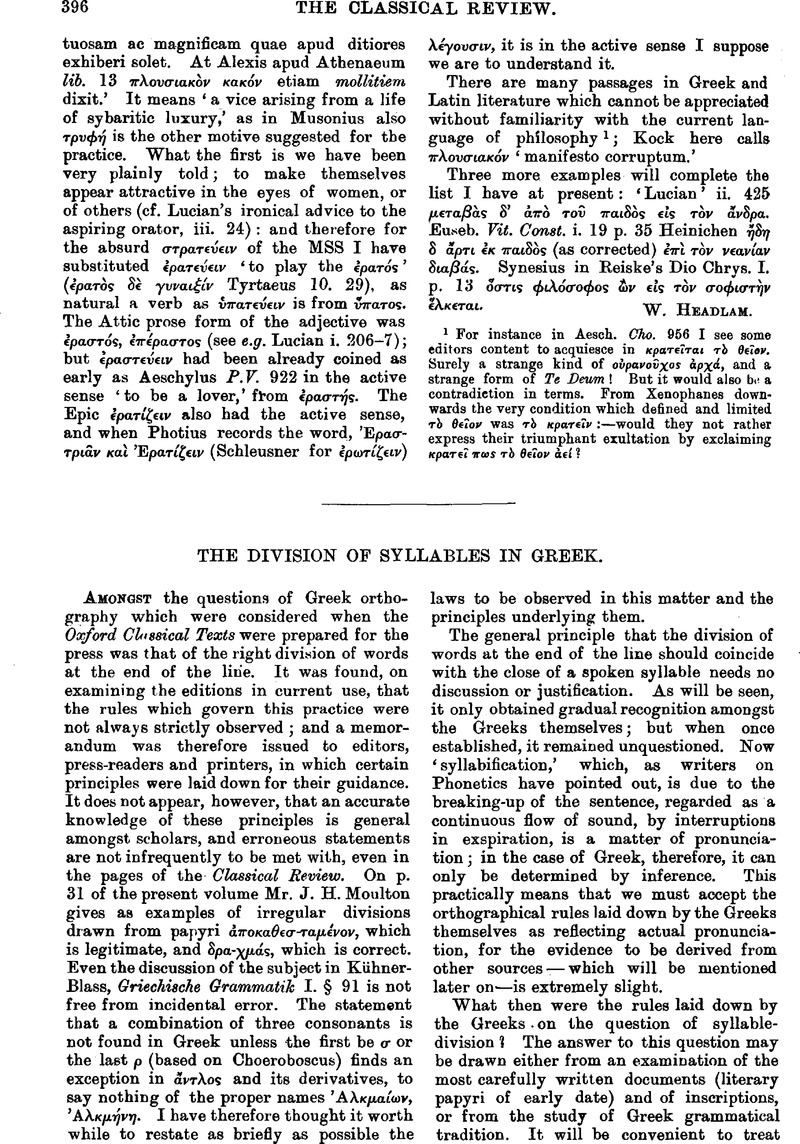No CrossRef data available.
Article contents
The Division of Syllables in Greek
Published online by Cambridge University Press: 27 October 2009
Abstract

- Type
- Original Contributions
- Information
- Copyright
- Copyright © The Classical Association 1901
References
page 397 note 1 Referenees to these will be found in Meisterhans Grammatik der attischen Inschriften 3, p. 7 f. Some inscriptions not there included amongst the examples of ‘ strict’ division might be added, as the exceptions are found in editorial supplements (C. I. A. II 465 and 468); while C.I.A. II 471 and 481 (which Meisterhans includes) shew φαν/ερο and προηρ/σια respectively.
page 397 note 2 Exaggerated statements have been made on this subject. Mr. Kenyon (Palaeography of Greek Papyri p. 31 n) rightly condemns Wattenbach's dictum that the division of words in Egyptian papyri is ‘ganz regellos’; but his own statement as to the accuracy even of non-literary papyri is far too sweeping. See the letters of Gemellus (No. 112)and Harpocration (No. 127) in Fayum Towns and their Papyri for examples of irregular division.
page 398 note 1 On the other hand we find -ξντες Fayum Towns and their Papyri xii 19/20.
page 398 note 2 Tryphon's definition of orthography is also quoted (Reitzenstein, op. cit. p. 303).
page 398 note 3 Adv. math. p. 638 Bk.
page 399 note 1 Consonants which are not separated in syllabledivision are said to be ν συλλΨει; those which are so separated are ν διαστσει.
page 399 note 2 Herodianus de orthographia ostendit rationabilius esse sonoriusque quantum ad ipsam vocis prolationem in compositis quoque simplicium regulam in ordinandis syllabarum litteris servare.
page 399 note 3 It is difficult to see what doubt could have arisen in the other instance given in this passage (-βριμος or β-ριμος, where the first division is the correet one). It seems possible that as the γ in such a word as φθγμα became nasalised and gave rise to the spelling φθγμαrecommended by Herodian (II 408 L), so β in βριμος may have been similarly affected (cp. the spelling μβριμος), and it may have been held by some that it should be treated as a nasal.
page 399 note 4 So too, though κ before-consonants was ν διαστσει, ξ formed no exception to the usual rule. Papyri shew divergences in this case, as was shewn above.
page 399 note 5 Lentz II. 398, 17 ff.
page 400 note 1 Sweet, V., Handbook of Phonetics, p. 59Google Scholar. The Romance languages do not possess anything like so rich a gamut of quantity as those of the Teutonic family, and ancient Greek was probably like them in this respect.
page 400 note 2 In Heph. p. 34 Stud.
page 400 note 3 De comp. verb. c. 15.
page 400 note 4 P. 39, 6 ff. K.


